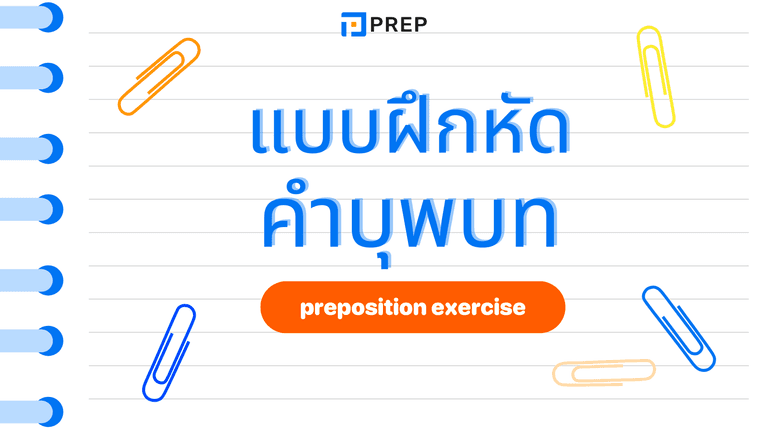เรียนรู้ 8 ประเภทของ Special Passive Voice ในภาษาอังกฤษ
Special Passive Voice ในภาษาอังกฤษเป็นหัวข้อไวยากรณ์ที่สำคัญ มี Passive Voice กี่ประเภท โครงสร้างและการใช้งานของ Special Passive Voice คืออะไร เรามาสำรวจด้านนี้กันเพิ่มเติมด้วย PREP ในบทความด้านล่างนี้
- I. Passive Voice คืออะไร
- II. โครงสร้างของ Special Passive Voice ในภาษาอังกฤษ
- 1. 1 verb + 2 objects
- 2. 1 verb + 1 object + 1 infinitive verb พร้อม “to”
- 3. 1 verb + 1 object + 1 bare infinitive verb (ไม่มี “to”)
- 4. 1 verb + 1 object + 1 gerund
- 5. 1 verb + 1 infinitive verb/gerund + 1 object
- 6. 1 verb + 1 object + object’s complement
- 7. 1 verb + 1 that-clause
- 8. Have/get something done
- III. แบบฝึกหัด Special Passive Voice ในภาษาอังกฤษพร้อมเฉลย

I. Passive Voice คืออะไร
Passive Voice ทำให้เน้นว่าบุคคลหรือวัตถุใดได้รับผลกระทบจากการกระทำ มากกว่าที่จะบอกว่าใครเป็นผู้กระทำการนั้น Tense ที่ใช้ใน Passive Voice ต้องสอดคล้องกับที่ใช้ในรูปแบบ Active Voice ตัวอย่างเช่น
|
Active Voice |
➡ |
Passive Voice |
|
Tom wrote the book. (Tom เขียนหนังสือนั้น) |
➡ |
The book was written by Tom. (หนังสือถูกเขียนโดย Tom) |
|
She is eating the cake. (เธอกำลังกินเค้ก) |
➡ |
The cake is being eaten (by her). (เค้กกำลังถูกกิน (โดยเธอ)) |
|
They will build a new bridge. (พวกเขาจะสร้างสะพานใหม่) |
➡ |
A new bridge will be built by them. (สะพานใหม่จะถูกสร้างโดยพวกเขา) |
ในประโยค Passive Voice ข้างต้น ประธานเปลี่ยนจากบุคคลหรือวัตถุที่ทำการกระทำ (Tom, She, They) เป็นวัตถุที่ได้รับผลกระทบจากการกระทำ (The book, The cake, A new bridge) และกริยาก็เปลี่ยนไปใช้รูป Passive Voice โดยการเติม “be” (was, is being, will be).
ประโยค Passive Voice ถูกใช้ในน้ำเสียงที่เป็นกลางและโฟกัสมากขึ้นที่การกระทำมากกว่าผู้ที่ทำการกระทำ (ซึ่งช่วยหลีกเลี่ยงการวิจารณ์โดยตรง)
II. โครงสร้างของ Special Passive Voice ในภาษาอังกฤษ
ด้านล่างนี้คือสรุปโครงสร้างที่ใช้บ่อยที่สุดของประโยค Special Passive Voice ในภาษาอังกฤษ มาเรียนรู้ด้วยกันกับ PREP เกี่ยวกับมีโครงสร้างของ Special Passive Voice กี่แบบและวิธีการใช้
1. 1 verb + 2 objects

|
โครงสร้าง |
ตัวอย่าง |
|
|
Active Voice |
Passive Voice |
|
|
S + V + กรรมรอง + กรรมตรง |
My teacher gives me the assignment. (คุณครูของฉันให้การบ้านกับฉัน) |
I am given the assignment by my teacher. (ฉันได้รับการบ้านจากคุณครู) |
|
V + กรรมรอง + คำบุพบท (to) + กรรมรอง |
My teacher gives the assignment to me. (คุณครูของฉันให้การบ้านนั้นแก่ฉัน) |
The assignment is given to me. (การบ้านถูกให้แก่ฉัน) |
2. 1 verb + 1 object + 1 infinitive verb พร้อม “to”
|
โครงสร้าง |
ตัวอย่าง |
|
|
Active Voice |
Passive Voice |
|
|
กริยาสถานะ: like, hate, love, want, wish, prefer, hope,… + object + to V ➡ รูป passive voice จะถูกสร้างขึ้นโดยใช้รูป past participle ของ infinitive verb S + V + O + tobe VP2 |
Do you want me to serve dinner now? (ให้ฉันเสิร์ฟอาหารเย็นตอนนี้ไหมคะ) |
Do you want dinner to be served now? (ให้อาหารเย็นเสิร์ฟตอนนี้ไหม) |
|
ถ้า กรรม ของ infinitive verb อ้างอิงถึงสิ่งเดียวกันกับ ประธาน ของประโยค แล้วรูป Passive Voice จะถูกสร้างขึ้นโดยไม่มี กรรม S + V + to be + VP2 |
She wants people to call her “Madam”. (เธออยากให้คนเรียกเธอว่า “Madam”) |
She wants to be called “Madam”. (เธออยากถูกเรียกว่า “Madam”) |
|
กริยาที่แสดงคำสั่ง คำขอ อนุญาต คำแนะนำ คำเชิญ: ask, request, tell, order, advise, invite, allow,... + O + to V รูป Passive Voice จะถูกสร้างขึ้นโดยใช้รูป past participle ของกริยาหลัก S + passive verb + to V |
He asked me to send a stamped envelope. (เขาขอให้ฉันส่งซองจดหมายที่มีแสตมป์แล้ว) |
I was asked to send a stamped envelope. (ฉันถูกขอให้ส่งซองจดหมายที่มีแสตมป์แล้ว) |
3. 1 verb + 1 object + 1 bare infinitive verb (ไม่มี “to”)
กริยาที่บ่งบอกถึงความรู้สึก: feel, see, watch, notice, hear, listen to,... + O + V ➡ รูป passive จะถูกสร้างขึ้นโดยใช้รูป past participle ของกริยาหลัก - bare infinitive verb (ไม่มี “to”).
โครงสร้าง
S + Passive V + to V
ตัวอย่าง:
|
Active Voice |
➡ |
Passive Voice |
|
I heard her run upstairs. (ฉันได้ยินเธอวิ่งขึ้นไปชั้นบน) |
➡ |
She was heard to run upstairs. (เธอถูกได้ยินว่าวิ่งขึ้นไปชั้นบน) |
|
I felt something to fall down. (ฉันรู้สึกว่ามีบางอย่างตกลงมา) |
➡ |
Something was felt to fall down. (มีบางอย่างถูกรู้สึกว่าตกลงมา) |
หมายเหตุ Make และ Help ก็ถูกรวมอยู่ในกรณีนี้ ตัวอย่าง:
|
Active Voice |
➡ |
Passive Voice |
|
She made him tell the truth. (เธอทำให้เขาบอกความจริง) |
➡ |
He was made to tell the truth. (เขาถูกทำให้บอกความจริง) |
|
The teacher helps students to do homework. (ครูช่วยนักเรียนในการทำการบ้าน) |
➡ |
The students are helped to do homework by the teacher. (นักเรียนได้รับความช่วยเหลือจากครูในการทำการบ้าน) |
บทความแนะนำอ่านเพิ่มเติม: Causative Verb คืออะไร? สรุปหลักการใช้ง่าย ๆ ใน 5 นาที
4. 1 verb + 1 object + 1 gerund
กริยาตามด้วย object + gerund: see, hear, find, stop, keep… + object + V-ing รูป passive จะถูกสร้างขึ้นโดยใช้รูป past participle ของกริยาหลัก
โครงสร้าง:
S + Passive verb + V-ing
ตัวอย่าง:
|
Active Voice |
➡ |
Passive Voice |
|
He kept me waiting. (เขาทำให้ฉันรอ) |
➡ |
I was kept waiting. (ฉันถูกทำให้รอ) |
|
My mother stopped me from crossing the road. (แม่ของฉันห้ามฉันข้ามถนน) |
➡ |
I was stopped crossing the road. (ฉันถูกห้ามข้ามถนน) |
หมายเหตุ เมื่อกรรมของ gerund อ้างอิงถึงสิ่งเดียวกันกับประธานของประโยค รูป passive จะถูกสร้างขึ้นโดยใช้รูป passive ของ gerund
S + V + Passive gerund (being + VP2)
ตัวอย่าง:
|
Active Voice |
➡ |
Passive Voice |
|
He doesn’t like people laughing at him. (เขาไม่ชอบคนหัวเราะเยาะเขา) |
➡ |
He doesn’t like being laughed at. (เขาไม่ชอบถูกหัวเราะเยาะ) |
|
She likes people going pleased and complimenting her. (เธอชอบคนมีความสุขและชมเชยเธอ) |
➡ |
She likes being given pleased compliments. (เธอชอบถูกชมเชยด้วยคำที่น่าพอใจ) |
5. 1 verb + 1 infinitive verb/gerund + 1 object
บางกริยาเช่น advise, agree, insist, arrange, suggest, propose, recommend, determine, decide, demand ฯลฯ,... + to V/gerund + O รูป passive จะถูกแสดงใน that-clause
โครงสร้าง
S + V + that + S + Should be + V(P2)

ตัวอย่าง:
|
Active Voice |
➡ |
Passive Voice |
|
He decided to take that position. (เขาตัดสินใจที่จะรับตำแหน่งนั้น) |
➡ |
He decided that the position should be taken. (เขาตัดสินใจว่าตำแหน่งนั้นควรถูกรับ) |
|
We recommend changing your internet provider. (เราแนะนำให้เปลี่ยนผู้ให้บริการอินเทอร์เน็ตของคุณ) |
➡ |
We recommend that your internet providers should be changed. (เราแนะนำว่าผู้ให้บริการอินเทอร์เน็ตของคุณควรถูกเปลี่ยน) |
6. 1 verb + 1 object + object’s complement
วัตถุกรรมโดยตรงหลังจากบางกริยาสามารถตามด้วยเสริมของวัตถุกรรม (คำนามหรือคำคุณศัพท์) ในประโยค Special Passive Voice ในภาษาอังกฤษเสริมแต่งเหล่านี้กลายเป็นของประธานและตามหลังกริยา
ตัวอย่างเช่น:
|
Active Voice |
➡ |
Passive Voice |
|
I believed him innocent. (ฉันเชื่อว่าเขาไม่มีความผิด) |
➡ |
He was believed innocent. (เขาถูกเชื่อว่าไม่มีความผิด) |
|
They elected my father president. (พวกเขาเลือกพ่อของฉันเป็นประธาน) |
➡ |
My father was elected president. (พ่อของฉันถูกเลือกเป็นประธาน) |
7. 1 verb + 1 that-clause
เมื่อใช้ อนุประโยค "that" เป็นวัตถุกรรมกับกริยาเช่น: agree, allege, announce, assume, hope, believe, claim, consider, estimate, expect, feel, find, know, report, rumor, say, think, understand,... ประโยค Special Passive Voice ในภาษาอังกฤษมีสามโครงสร้างดังนี้:
|
โครงสร้าง |
ตัวอย่าง |
|
|
Active Voice |
Passive Voice |
|
|
S + passive verb + to V (ถ้าสองกริยาอยู่ในเครียดเดียวกัน) |
People say that she is a good teacher. (คนบอกว่าเธอเป็นครูที่ดี) |
She is said to be a good teacher. (เธอถูกบอกว่าเป็นครูที่ดี) |
|
S + passive verb + to have VP2 (V2 เกิดขึ้นหลังจาก V1) |
People know that he was a spy. (คนรู้ว่าเขาเคยเป็นสายลับ) |
He is known to have been a spy. (เขาถูกทราบว่าเคยเป็นสายลับ) |
|
It + passive verb + อนุประโยค that (ประธานไร้ความหมาย (Dummy subject) คือ “It”) |
People say that I learn English very well. (คนบอกว่าฉันเรียนภาษาอังกฤษได้ดีมาก) |
It is said that I learn English very well. (มันถูกบอกว่าฉันเรียนภาษาอังกฤษได้ดีมาก) |
บทความแนะนำอ่านเพิ่มเติม:
โครงสร้างและการใช้ Double Passive Voice ภาษาอังกฤษ
วิธีใช้ Gerund Infinitive เข้าใจง่ายใน 5 นาที
โครงสร้าง หน้าที่ และวิธีการใช้ Perfect gerund ในภาษาอังกฤษ
8. Have/get something done
เราใช้ "Have/get something done" - โครงสร้าง Special Passive Voice ในภาษาอังกฤษเพื่อบรรยายว่าบางอย่างถูกทำให้เสร็จสมบูรณ์หรือได้รับการจบการทำ ตัวอย่างเช่น
ตัวอย่าง
- I have my house painted green. (ฉันทำให้บ้านของฉันถูกทาสีเป็นสีเขียว)
- I get my clothes ironed smoothly. (ฉันทำให้เสื้อผ้าของฉันถูกรีดให้เรียบ)

III. แบบฝึกหัด Special Passive Voice ในภาษาอังกฤษพร้อมเฉลย
แบบฝึกหัด: แปลงประโยคต่อไปนี้เป็น special passive voice
- It is impossible for us to complete the exercise in 30 minutes.
- They make me do housework alone.
- I have my father repair my motorbike.
- People said that he had been very thrifty.
- People believe that their director is very rich.
- They need to clean the car.
- My friends elected me as the monitor.
- My teacher gives me the assignment.
- She made him tell the truth.
- She doesn’t like people laughing at her.
เฉลย
- It is impossible for the exercise to be completed in 30 minutes.
- I am made to do housework alone.
- I have my motorbike repaired by my father.
- He was said to have been very thrifty.
- It is believed that their director is very rich.
- The car needs cleaning.
- I was elected monitor by my friends.
- I am given the assignment by my teacher.
- He was made to tell the truth.
- He doesn’t like being laughed at.
ในบทความนี้ Prep ได้รวบรวมโครงสร้างประโยค Special Passive Voice ในภาษาอังกฤษจำนวน 8 แบบ พร้อมกับแบบฝึกหัดสำหรับการทบทวนแนวคิด เพิ่มเติมหากคุณต้องการพัฒนาไวยากรณ์ภาษาอังกฤษของคุณให้ดียิ่งขึ้น อย่าลืมติดตามบทความที่อัพเดททุกวันจาก Prep!
เรียน IELTS ออนไลน์สะดวกสบายกับเทคโนโลยี Prep AI! แผนตารางเรียน IELTS ที่ปรับให้เหมาะสมกับคุณ ช่วยให้คุณเรียนได้อย่างมีประสิทธิภาพที่บ้าน เข้าร่วมหลักสูตร IELTS คุณภาพสูงที่นี่ หรือโทร HOTLINE +6624606789 เพื่อรับข้อเสนอพิเศษวันนี้! ดาวน์โหลดแอป PREP และเรียน IELTS ที่บ้านกับโปรแกรมฝึกสอบออนไลน์คุณภาพสูง พร้อมการสนับสนุน 1-1 จาก Teacher Bee AI ผู้ช่วยเสมือนที่จะคอยช่วยเหลือและร่วมเดินทางไปกับคุณตลอดกระบวนการเรียนรู้

สวัสดีค่ะ ฉันชื่อมุก ปัจจุบันดูแลด้านเนื้อหาผลิตภัณฑ์ของ Prep Education ค่ะ
ด้วยประสบการณ์มากกว่า 5 ปีในการเรียน IELTS ออนไลน์ด้วยตนเอง ฉันเข้าใจดีถึงความท้าทายที่ผู้เรียนต้องเผชิญ แล้วก็รู้ว่าอะไรที่มันเวิร์ก
มุกอยากเอาประสบการณ์ตรงนี้มาช่วยแชร์ แล้วก็ซัพพอร์ตเพื่อน ๆ ให้ได้คะแนนที่ดีที่สุดค่ะ
ความคิดเห็น
เนื้อหาแบบพรีเมียม
ดูทั้งหมดแผนการเรียนรู้ส่วนบุคคล
อ่านมากที่สุด
ติดต่อ Prep ผ่านโซเชียล
















